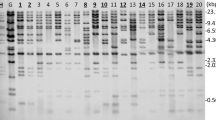Abstract
Genetic improvement of two different strains of the entomopathogenic fungus Beauveria bassiana for more effective control of Ostrinia nubilalis and Leptinotarsa decemlineata was obtained by crosses with the insecticidal toxin-producing strain Beauveria sulfurescens. Protoplast fusion between diauxotrophic mutants resulted in the recovery of some stable prototrophic fusion products. The low levels of virulence of the wild type strain B. bassiana 28 isolated originally from L. decemlineata were enhanced both on L. decemlineata and O. nubilalis for one of the hybrids obtained (FP 8) from the cross B. bassiana 28 × B. sulfurescens 2. Fusion product 25 obtained from the cross between B. sulfurescens and the highly pathogenic strain B. bassiana 147 showed a three-day reduction in the LT50 towards O. nubilalis. Southern blot hybridization with nine probe-enzyme combinations were conducted on genomic DNAs from the original wild strains, parental mutant strains, and fusion products. Additive banding patterns or unique banding pattern of either parental strain was observed in five hybrids, indicating their status as recombinant and/or partially diploïd. Combination of RFLP markers indicative of both parental genomes was never observed with fusion product FP 25. The stability of the virulence following passage through insect-host and stability of molecular structure for the fusion products FP 8 and FP 25 suggest that asexual genetic recombination by protoplast fusion may provide an attractive method for the genetic improvement of biocontrol efficiency in entomopathogenic fungi.
Similar content being viewed by others
References
Daboussi MJ, Djeballi A, Gerlinger C, Blaiseau PL, Bouvier I, Cassan M, Lebrun MH, Parisot D, Brygoo Y (1989) Transformation of seven species of filamentous fungi using the nitrate reductase gene of Aspergillus nidulans. Curr Genet 15:453–456
Fargues J, Cugier JP, Van de Weghe P (1980) Expérimentation en parcelles du champignon Beauveria bassiana (Hyphomycète) contre Leptinotarsa decemlineata (Col., Chrysomelidae). Acta Oecologica 1(1):49–61
Hastie AC (1970) Benlate-induced instability of Aspergillus diploids. Nature (London) 226:771
Gadau ME, Lingg AJ (1992) Protoplast fusion in fungi. In: Arora DK, Elander RP, Mukerji KG. (eds) Fungal biotechnology. (Handbook of applied mycology, vol 4) M. Dekker, New York, pp 101–129
Hocart MJ, McNaughton JE (1994) Interspecific hybridization between Pseudocercorporella herpotrichoides and P. anguioides achieved through protoplast fusion. Mycol Res 98(1):47–56
Kawamoto H, Aizawa K (1986) Fusion conditions for protoplasts of an entomogenous fungus, Beauveria bassiana. Appl Entom Zool 21:624–626
Kelman ET, Varga J, Kevei (1991) Characterization of interspecific hybrids within the Aspergillus nidulans group by isozyme analysis. Can J Bot 37:391–396
Mollier P, Lagnel J, Fournet B, Aioun A, Riba G (1994) A glycoprotein highly toxic for Galleria mellonella larvae secreted by the entomopathogenous fungus Beauveria sulfurescens. J Invert Pathol 64(3):200–208
Neuveglise C, Brygoo Y, Vercambre B, Riba G (1994) Comparative analysis of molecular and biological characteristics of strains of Beauveria brongniartii isolated from insects. Mycol Res 98(3):322–328
Paccola-Meirelles LD, Azevedo JL (1991) Parasexuality in Beauveria bassiana. J Invert Pathol 57:172–176
Paccola-Meirelles LD, Azevedo JL (1994) Genetic recombination by protoplast fusion in the Deuteromycete Beauveria bassiana. Rev Brasil Genet 17(1):15–18
Paris S (1977) Heterocaryons chez Beauveria tenella. Mycopathologia 61(2):67–75
Poprawski TJ, Riba G, Jones NA, Aioun A (1988) Variation in isoesterase profiles of geographical populations of Beauveria bassiana (Deuteromycotina: Hyphomycetes) isolated from Sitona weevils (Coleoptera: Curculionidae). Environ Entomol 17(2):275–279
Riba G, Marcandier S, Richard G, Larget I (1983) Sensibilité de la pyrale du maïs (Ostrinia nubilalis) (Lep. Pyralidae) aux Hyphomycètes entomopathogènes. Entomophaga 28:55–64
Riba G, Ravelojoana AM (1984) The parasexual cycle in the entomopathogenous fungus Paecilomyces fumosoroseus (Wize) Brown & Smith. Can J Microbiol 30:922–926
Riba G, Azevedo JL, Messias CL, Dias da Silveira W, Tuveson R (1986) Studies of the inheritance of virulence in the entomopathogenic fungus Metarhizium anisopliae. J Invert Pathol 46:20–25
Shimizu S (1987) Protoplast fusion of insect pathogenic fungi. In: Maramorosh K (ed) Biotechnology in invertebrate pathology and cell culture. Academic Press, San Diego, pp 401–414
Silveira WD, Azevedo JL (1987) Protoplas fusion and genetic recombination in Metarhizium anisopliae. Enzyme Microb Technol 9:149–152
Author information
Authors and Affiliations
Rights and permissions
About this article
Cite this article
Couteaudier, Y., Viaud, M. & Riba, G. Genetic nature, stability, and improved virulence of hybrids from protoplast fusion in Beauveria . Microb Ecol 32, 1–10 (1996). https://doi.org/10.1007/BF00170102
Received:
Revised:
Issue Date:
DOI: https://doi.org/10.1007/BF00170102




